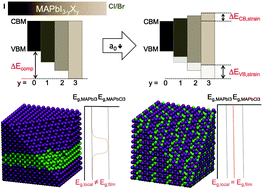Systematic analysis of the unique band gap modulation of mixed halide perovskites†
Abstract
Solar cells based on organic–inorganic hybrid metal halide perovskites have been proven to be one of the most promising candidates for the next generation thin film photovoltaic cells. Mixing Br or Cl into I-based perovskites has been frequently tried to enhance the cell efficiency and stability. One of the advantages of mixed halides is the modulation of band gap by controlling the composition of the incorporated halides. However, the reported band gap transition behavior has not been resolved yet. Here a theoretical model is presented to understand the electronic structure variation of metal mixed-halide perovskites through hybrid density functional theory. Comparative calculations in this work suggest that the band gap correction including spin–orbit interaction is essential to describe the band gap changes of mixed halides. In our model, both the lattice variation and the orbital interactions between metal and halides play key roles to determine band gap changes and band alignments of mixed halides. It is also presented that the band gap of mixed halide thin films can be significantly affected by the distribution of halide composition.


 Please wait while we load your content...
Please wait while we load your content...